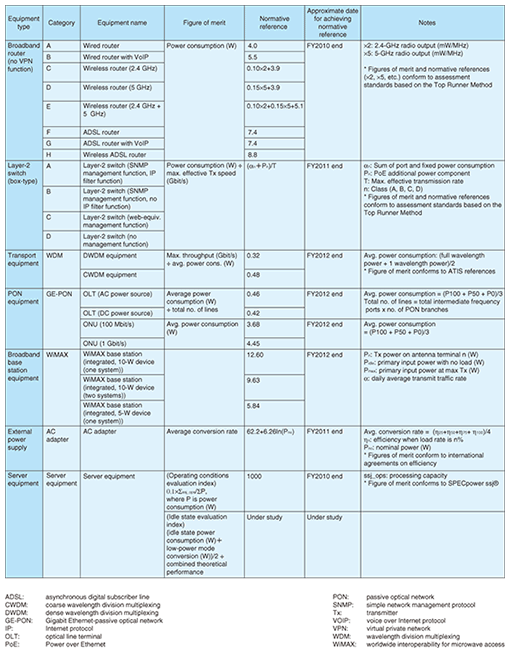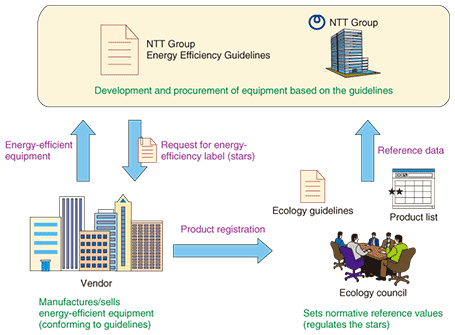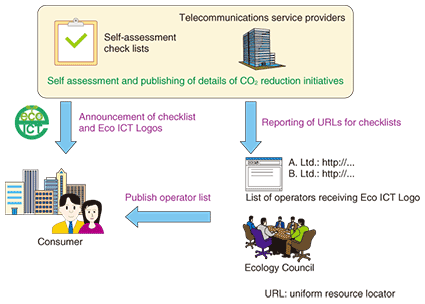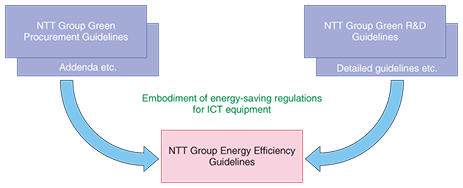 |
|||||||||||||||||||||||||
|
|
|||||||||||||||||||||||||
|
Feature Articles: Environment and Energy Technologies Toward a Green Society Vol. 9, No. 2, pp. 50–56, Feb. 2011. https://doi.org/10.53829/ntr201102fa8 NTT Group Energy Efficiency Guidelines Initiative and Promotion of Green R&DAbstractIn April 2010, the NTT Group Energy Efficiency Guidelines were created with the goal of reducing the NTT Group’s energy costs as well as its environmental load. The guidelines establish evaluation methods and set target standards for power-consumption efficiency in information and communications technology (ICT) equipment. They were accompanied by revisions to the “Detailed Guidelines for the Green Assessment of R&D Results”, which is part of the NTT Group Green R&D Guidelines. This article introduces the background and current state of this series of initiatives.
1. ICT Ecology GuidelinesAs services continue to diversify and traffic on the networks of telecommunications service providers increases, the power consumed by information and communications technology (ICT) equipment comprising the networks, air conditioners, power supplies, and other accompanying equipment, as well as the amount of CO2 emitted as a result, are increasing in proportion. In response, the Ministry of Internal Affairs and Communications released a report in June 2009 entitled “Study Group on Ecological Measures in the ICT Field” [1]. This report stated that if telecommunications service providers would, at their own initiative, procure equipment designed to conserve energy and increase the visibility of their CO2 emissions reduction initiatives, it would be effective in reducing CO2 emissions. Accordingly, NTT and other telecommunications service providers created the ICT Ecology Guideline Council (Ecology Council [2]) in June 2009. It produced the ICT Ecology Guidelines (1st ed.) (Ecology Guidelines [3]) in February 2010 to establish procurement standards for telecommunications services providers for the purpose of evaluating the energy efficiency of ICT equipment and services. These guidelines indicate (1) assessment standards for evaluating applicable equipment, (2) assessment standards for evaluating datacenters, and (3) assessment standards for obtaining the Eco ICT Logo designation. 2. Standards for evaluating energy savings in ICT equipmentThe Ecology Guidelines ver. 1.1 (revised on Dec. 27, 2010) stipulate figures of merit, normative references, and approximate dates for achieving the normative references for seven types of ICT equipment such as routers and servers*1 (Table 1). The figure of merit for each type of ICT equipment was determined with due consideration for energy-saving methods, assessment standards from standards organizations, and also actual operational conditions. Furthermore, technical trends and other factors were also taken into account when setting each normative reference and the approximate date for its achievement. Threshold values in five steps were also set to evaluate the degree to which ICT equipment achieves a given normative reference. For example, if the relative reduction in energy consumption exceeds the normative reference by 10–20%, it is given three stars, if it exceeds the normative reference by 20–30%, it gets four stars, and if it does not meet the normative reference, it gets only a single star (Table 2).
It is assumed that manufacturers will conduct these evaluations themselves and that the product-evaluation results will be published on the council’s website. Telecommunications service providers will be able to refer to the results on the website when deciding their procurement standards.
3. NTT Group Energy Efficiency GuidelinesTo reduce CO2 emissions by the NTT Group, we are focusing on communications equipment and offices, which account for 90% of emissions by the group, in order to reduce power consumption. Accordingly, in April 2010, eight NTT-Group companies*2 established the NTT Group Energy Efficiency Guidelines (1st ed.) (Energy Efficiency Guidelines [4], [5]), on the basis of the Ecology Guidelines, in order to support development and procurement of equipment with high energy-efficiency for NTT Group companies. The Energy Efficiency Guidelines ver. 1.1 (revised on Dec. 27, 2010) represent the basic approach to developing and procuring ICT equipment for the NTT Group. Some key extracts from them are shown in Fig. 1.
To encourage manufacturers to meet target values for equipment types as far as possible when applying these guidelines, manufacturers are required to indicate specific requirement items and show how they were evaluated in their technical specification documents. Moreover, the suitability of energy-saving-performance-guideline target values for each equipment group will be reexamined according to product trends. An overview of the operational flow for the guidelines is shown in Fig. 2. In the future, we will promote their application beyond the initial eight group companies.
4. Eco ICT LogoThe Eco ICT Logo shows that a telecommunications service provider is taking appropriate initiatives to reduce CO2 emissions. The Ecology Council began accepting applications for the Eco ICT Logo and publishing the names of companies receiving it in July 2010. The eight NTT companies that established the Energy Efficiency Guidelines have all received the Eco ICT Logo [6], [7]. The process for receiving the Eco ICT Logo is shown in Fig. 3. The Ecology Guidelines establish items that companies must check themselves regarding the state of their CO2 emissions reduction initiatives. These items include mainly whether the company is creating equipment procurement standards, whether it is conducting procurement according to these standards, whether it has a voluntary environmental action plan describing CO2 emission reduction target values, whether it is operating according to this plan, and whether it has any initiatives, staff announcements, or developments, besides CO2 reduction ones, toward reducing its environmental load. The Ecology Guidelines include eight mandatory items and two optional items. Telecommunications service providers can obtain the Eco ICT Logo by fulfilling all the mandatory items and publishing the results of their self-assessment on their own websites. In the future, this Eco ICT Logo will be displayed on the websites and in corporate social responsibility reports of companies that have received it, and we will continue to widely promote NTT Group efforts to reduce CO2 emissions.
5. NTT Group Green R&D GuidelinesIn the NTT Group, we established the NTT Global Environmental Charter in 1991 and are promoting environmental protection measures throughout the company. In 2000, the NTT Group Green R&D Guidelines were established as an initiative toward research and development (R&D) taking the environment into consideration. Then, in 2004, the R&D Green Assessment Detailed Guidelines (GA Detailed Guidelines) were established and assessments based on these guidelines are instituted when R&D is started and when the results are provided to businesses, promoting ongoing efforts for environmental improvement. In particular, from the outset, R&D must consider compatibility with issues such as the selection and compatibility of materials, restricted use of toxic substances, conservation of resources and energy, ease of disassembly and disposal, and methods for recycling and disposal. The energy efficiency of ICT devices and other R&D products are also evaluated (Green of ICT), as well as the effect of reducing the overall load of society on the environment (Green by ICT) through aspects such as improving distribution efficiency, reducing the movement of people and materials, and dematerialization. With this introduction of Energy Efficiency Guidelines, the GA Detailed Guidelines have also been revised so that in the future, in addition to previously evaluation items, conformance to the target values for each equipment group in the energy-saving guidelines will also be evaluated. Finally, the NTT Group Green Procurement Guidelines [8] and the (Addendum) Green Procurement Guidelines [9], which establish the idea of reducing environmental load from a procurement perspective, have also been revised. The relationships among these guidelines are shown in Fig. 4.
6. Future prospectsIn the future, we will continue to revise the Energy Efficiency Guidelines in accordance with the Ecology Guidelines and technical trends for ICT equipment, promote the application of these guidelines in group companies besides the original eight companies, and further expand initiatives within NTT to reduce CO2. The NTT Group will endeavor to create R&D results that have less environmental load (Green of ICT) and that help reduce the environmental load of society (Green by ICT) and will continue to promote policies at the R&D level that consider the environment. References
|
|||||||||||||||||||||||||



















